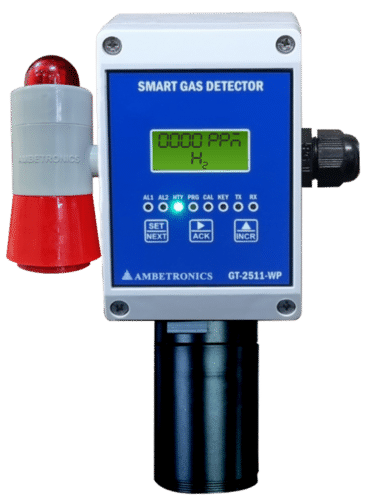- Gas Detector
- Gas Monitors
- Gas Analyzer
- Fixed Data Logger Scanner
- Clean Room Monitoring Equipment
- Internet Of Things (IoT)
- Temperature Humidity Transmitter
- Digital Stroboscope Tachometer
- Vibration Monitoring Equipments
- Gas Detection System
- Process Control Instruments
- Data Loggers
- Portable Gas Detectors
- Process Indicators
- Gas Alarm
- Calibration Kit
- Data Converters
- IIoT Loggers-Gateways
- Temperature Transmitter
- Sensors
- Gas Leak Detector
- Universal Data Logger
- Gas Leak Alert

Self-Powered Sensors
8000.00 - 30000.00 INR/Piece
Product Details:
X
Self-Powered Sensors Price And Quantity
- 8000.00 - 30000.00 INR/Piece
- 1 Piece
Self-Powered Sensors Trade Information
- 250 Piece Per Month
- 2 Week
Product Description
A self-powered sensor, also known as an energy harvesting sensor, is a type of sensor that can operate without relying solely on external power sources like batteries or electrical connections. Instead, it generates its own energy to power its functionality using various energy harvesting techniques. These sensors are designed to be more sustainable, cost-effective, and environmentally friendly since they reduce the need for frequent battery replacements or external power supplies.
Some common energy harvesting methods used in self-powered sensors include:
1. Solar energy harvesting: These sensors use photovoltaic cells to convert sunlight into electrical energy. They are particularly useful for outdoor applications where sufficient sunlight is available.
2. Piezoelectric energy harvesting: This method involves converting mechanical vibrations or motion into electrical energy using piezoelectric materials. It is often employed in sensors placed in environments with vibrations or movements, such as industrial machinery or even human movement in wearable devices.
3. Thermoelectric energy harvesting: In this approach, temperature differences are used to generate electricity through thermoelectric materials. Sensors can use the temperature gradients present in the environment or from the heat generated by their own operations.
4. Radiofrequency (RF) energy harvesting: Some sensors can harness ambient radiofrequency signals to convert them into electrical power, especially in settings with wireless communication devices.
5. Vibration energy harvesting: Similar to piezoelectric harvesting, vibration energy harvesting converts mechanical vibrations into electricity using electromagnetic or piezoelectric mechanisms.
6. Electromagnetic energy harvesting: These sensors use electromagnetic induction to generate power from nearby electromagnetic fields or alternating currents.
FAQ:
Q: What is a self-powered sensor?
A: A self-powered sensor, also known as an energy harvesting sensor, is a type of sensor that generates its own electrical energy to operate, eliminating the need for external power sources like batteries or electrical connections.
Q: How does a self-powered sensor work?
A: Self-powered sensors use energy harvesting techniques to convert ambient energy from the environment into electrical power. Common methods include solar energy harvesting, piezoelectric energy conversion from mechanical vibrations, thermoelectric energy conversion from temperature gradients, and radiofrequency (RF) energy harvesting.
Q: What are the advantages of self-powered sensors?
A: Self-powered sensors offer several advantages, including:
- Reduced reliance on batteries or external power supplies, leading to longer operational lifespans.
- Lower maintenance costs and reduced waste from battery replacements.
- Environmentally friendly and sustainable operation.
- Greater flexibility in sensor placement, especially in remote or hard-to-reach locations.
Q: What are the typical applications of self-powered sensors?
A: Self-powered sensors find applications in various fields, such as:
- Environmental monitoring for weather, air quality, and water resources.
- Industrial automation and condition monitoring for machinery and equipment.
- Structural health monitoring for bridges, buildings, and infrastructure.
- Healthcare devices and wearable technology.
- Internet of Things (IoT) devices for smart cities and smart homes.
Q: Are there any limitations to self-powered sensors?
A: Yes, self-powered sensors have some limitations:
- The amount of harvested energy may vary based on environmental conditions, potentially limiting sensor functionality in certain situations.
- Energy harvesting methods may not be suitable for high-power applications.
- Sensor performance may be affected in low-light or low-energy environments.
- Designing efficient energy management systems is crucial to ensure consistent sensor operation.
Q: How do self-powered sensors impact the environment?
A: Self-powered sensors contribute to environmental sustainability by reducing the consumption of disposable batteries and minimizing electronic waste. By harnessing ambient energy, they have a lower carbon footprint compared to battery-powered sensors.
Q: Can self-powered sensors work indoors?
A: Yes, some self-powered sensors can work indoors, depending on the energy harvesting method and available ambient energy sources. For example, indoor light, vibrations, or temperature gradients can be harnessed for energy harvesting.
Q: What are the challenges of implementing self-powered sensors?
A: Implementing self-powered sensors comes with some challenges, including:
- Designing efficient energy harvesting systems that can generate sufficient power for the sensor's operation.
- Ensuring continuous sensor functionality under varying environmental conditions.
- Balancing power consumption with sensor capabilities for optimal performance.
- Managing energy storage and usage to accommodate intermittent energy availability.
Q: Are self-powered sensors more expensive than battery-powered sensors?
A: Initially, self-powered sensors might have a higher upfront cost due to the integration of energy harvesting components. However, they offer cost savings over time since they eliminate the need for regular battery replacements or external power supply maintenance.
Q: What is the future outlook for self-powered sensors?
A: The future for self-powered sensors looks promising. As energy harvesting technologies continue to advance, these sensors will likely become more efficient and affordable. Their widespread adoption is expected to increase in various industries, contributing to a greener and more sustainable future.
Enter Buying Requirement Details
Other Products in 'Sensors' category
 |
AMBETRONICS ENGINEERS PVT. LTD.
All Rights Reserved.(Terms of Use) Developed and Managed by Infocom Network Private Limited. |

 English
English Spanish
Spanish French
French German
German Italian
Italian Chinese (Simplified)
Chinese (Simplified) Japanese
Japanese Korean
Korean Arabic
Arabic Portuguese
Portuguese
